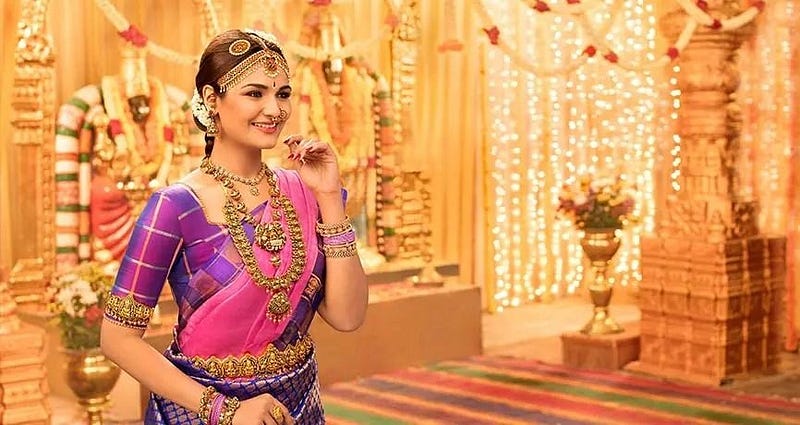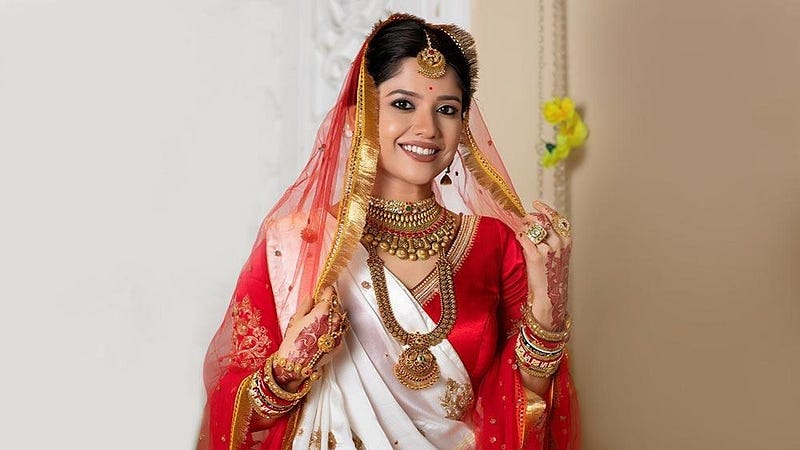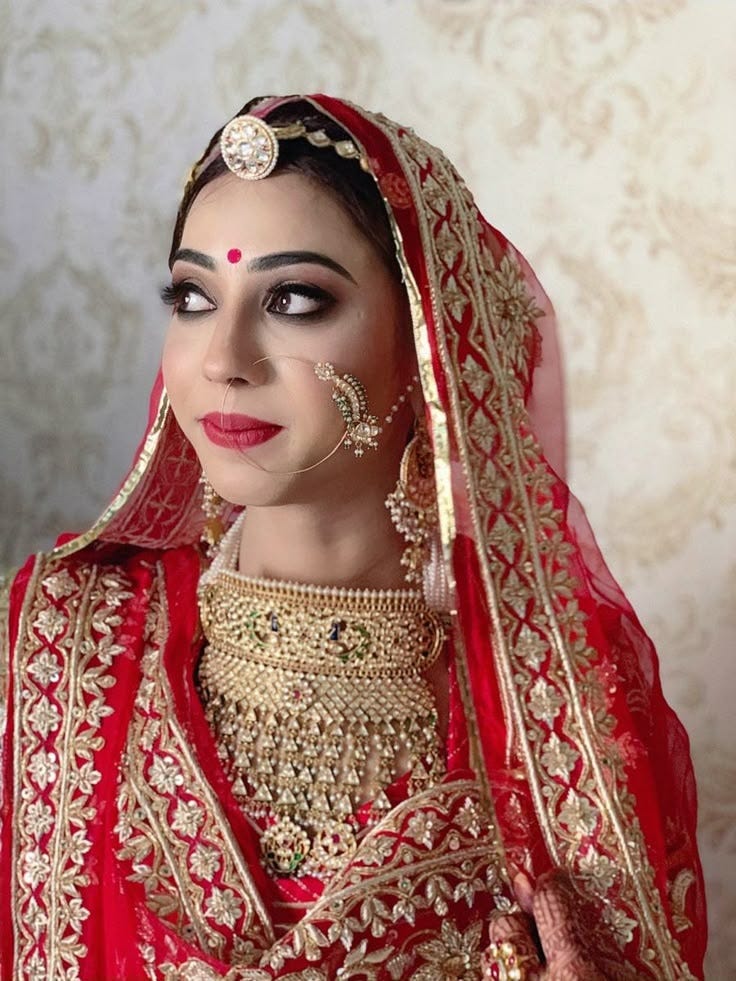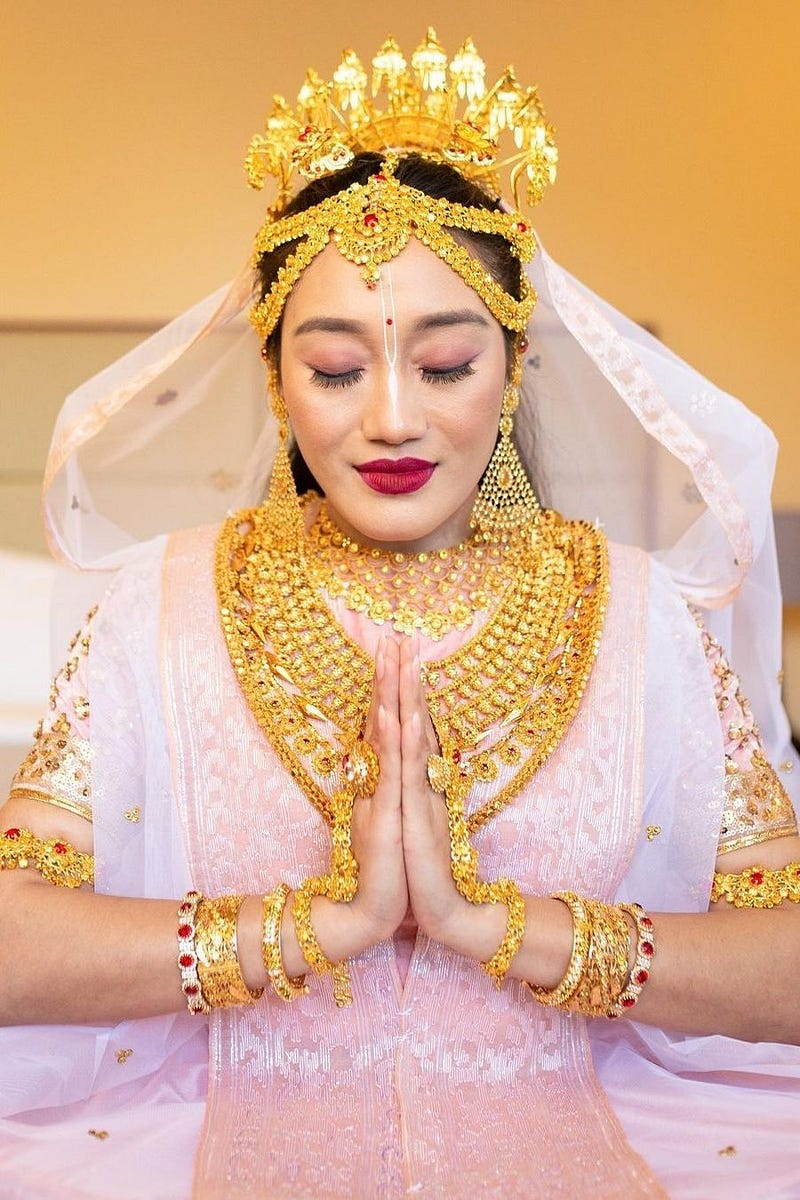Traditional Indian Bridal Looks That Define Every Region’s Charm

India, with its rich cultural heritage and diverse traditions, showcases a beautiful spectrum of bridal looks that vary from region to region. Every state in India has its unique customs, attire, jewelry, and rituals, and these differences define the charm and essence of a traditional Indian wedding. The bridal look is a reflection of the customs and beauty standards of that region, and it plays an important role in the wedding celebrations. From the intricate sarees of the South to the regal lehengas of the North, here’s a look at some of the most iconic traditional bridal looks from various regions of India:
1. North India — The Majestic Punjabi Bride

The Punjabi bride exudes warmth, joy, and exuberance. Her bridal look is often marked by bold colors and statement jewelry, perfect for the lively celebrations that come with a Punjabi wedding.
Attire: The Punjabi bride typically wears a lehenga choli or saree, with vibrant hues like red, maroon, or gold. The lehenga is usually heavy with intricate embroidery, and the choli can have modern cuts, making it an elegant fusion of tradition and contemporary style.
Jewelry: A key feature of the Punjabi bridal look is the chuda (a set of red and white bangles), often worn alongside a kalire (traditional bridal tassels). Additionally, brides adorn themselves with a matha patti (headpiece), nath (nose ring), and choker necklaces, giving them a regal look.
Makeup and Hairstyle: The makeup is usually bold with a focus on dramatic eyes, a strong contour, and a classic red or nude lip. The hair is often styled into a bun or a braid, decorated with flowers or jewelry.
2. South India — The Elegant Tamil & Telugu Bride

In South India bridal looks emphasize elegance, simplicity, and divine beauty. The bridal attire is all about grand silk sarees and gold jewelry, exuding a divine and regal charm.
Attire: South Indian brides traditionally wear a Kanjivaram silk saree, which is known for its rich colors, intricate designs, and luxurious feel. The saree is draped in a distinctive style, often with the pallu (the end piece of the saree) thrown over one shoulder, and paired with a traditional blouse.
Jewelry: Gold jewelry plays an essential role in the South Indian bridal look. The bride wears a variety of intricate gold ornaments like the vaddanam (waist chain), jhumkas (large earrings), mangalsutra (sacred necklace), and tikka. The bride’s hair is often decorated with fresh jasmine flowers and other traditional adornments.
Makeup and Hairstyle: The makeup is usually subtle, focusing on a glowing complexion and bold eyes. The hairstyle features a sleek bun or braid, which is often adorned with flowers like jasmine or roses.
3. West India — The Glamorous Gujarati Bride

The Gujarati bridal look is one of the most colorful and festive, characterized by beautiful bandhani or Patola sarees and unique jewelry. The vibrant celebrations and dance make this bridal look come alive with energy.
Attire: Gujarati brides typically wear a lehenga choli or a saree, often in bright colors like red, orange, or green. The bandhani print (tie-dye) is a common design, which adds an artistic touch to the outfit. The saree or lehenga is paired with a choli (blouse) that has intricate work, often adorned with mirror work or zardozi embroidery.
Jewelry: Gujarati brides wear extensive jewelry, including mangalsutra, bajubandh (arm bands), kankan (bangles), nath (nose ring), maang tikka, and a rakhdi (head ornament). The bridal jewelry is often a blend of traditional gold and contemporary pieces.
Makeup and Hairstyle: The makeup is striking with bold eyes, a defined look, and a deep red lip. The hair is styled into soft waves or a traditional bun, and adorned with a floral garland or a decorative hairpiece.
4. East India — The Graceful Bengali Bride

The Bengali bridal look is synonymous with grace, elegance, and tradition. The outfit and jewelry of a Bengali bride are known for their understated beauty and intricate details.
Attire: The Bengali bride wears a traditional saree, often in a beautiful white and red combination, which symbolizes purity and marital bliss. The saree is usually made of tant or baluchari fabric and is draped in the Bengali style, which is unique and elegant.
Jewelry: Bengali brides are known for their elaborate gold jewelry, which includes the shankha (conch shell bangles), polki necklaces, maang tikka, and borla (headpiece). The bridal look also includes a delicate nath (nose ring), which is an important part of Bengali tradition.
Makeup and Hairstyle: The makeup is soft yet distinct, with a focus on the eyes and a classic red bindi. The hair is usually styled in an elegant bun or braid, often adorned with white jasmine flowers, which is a signature element of the Bengali bridal look.
5. Central India — The Royal Rajasthani Bride

Rajasthan’s bridal look is characterized by its regal feel, with its opulent attire, heavy gold jewelry, and traditional beauty rituals. The Rajasthani bride reflects the royal grandeur of the region’s culture.
Attire: Rajasthani brides often wear a lehenga choli or ghagra choli, which is rich in color and fabric. The lehenga is typically embroidered with zari work or mirror work, showcasing the region’s rich handicrafts. The outfit often comes in deep hues of red, maroon, or gold, which are symbolic of fertility and prosperity.
Jewelry: The jewelry of a Rajasthani bride is both heavy and luxurious. It includes maang tikka, matha patti, nath (nose ring), bajubandh (arm bands), and haath phool (hand jewelry). Gold and silver are prominently used in their jewelry designs, which reflects the royal heritage of Rajasthan.
Makeup and Hairstyle: The Rajasthani bridal look emphasizes bold, dramatic eyes and a flawless complexion. The hair is usually styled in a bun or braid, decorated with traditional hairpieces or flowers. The bride is also known to wear a ghunghat (veil) over her head, adding an air of mystery and tradition.
6. Northeast India — The Traditional Assamese Bride

The Northeast region of India, especially Assam, has a unique and distinct bridal look, celebrated for its simplicity, grace, and deep cultural significance.
Attire: The Assamese bride wears the traditional mekhela chador, a two-piece outfit that is elegant and graceful. The chador is a draped garment, usually in silk, and is often adorned with traditional motifs. The colors typically range from gold and cream to red.
Jewelry: Assamese brides wear jewelry that’s quite different from other Indian regions. They often wear jonbiri (gold jewelry), matmara (a specific type of necklace), bichua (toe rings), and sital pati (wristbands made from bamboo). Their jewelry is elegant yet very symbolic of Assamese culture.
Makeup and Hairstyle: The Assamese bridal look is subtle and soft, with minimal makeup and a focus on natural beauty. The hair is styled in an elegant bun or braid, decorated with traditional floral adornments.
Conclusion
India’s bridal looks are as diverse as its culture, with every region showcasing its own distinctive traditions, attire, and customs. From the vibrant colors and lavish lehengas of North India to the regal silk sarees of the South, the country’s bridal styles represent centuries of cultural heritage and artistry. These traditional bridal looks not only define the charm of each region but also bring out the timeless beauty and significance of Indian weddings. Whether you’re drawn to the opulence of Rajasthan, the elegance of Bengal, or the vibrancy of Gujarat, each bridal look tells a beautiful story that’s rich in culture and tradition.
Comments
Post a Comment